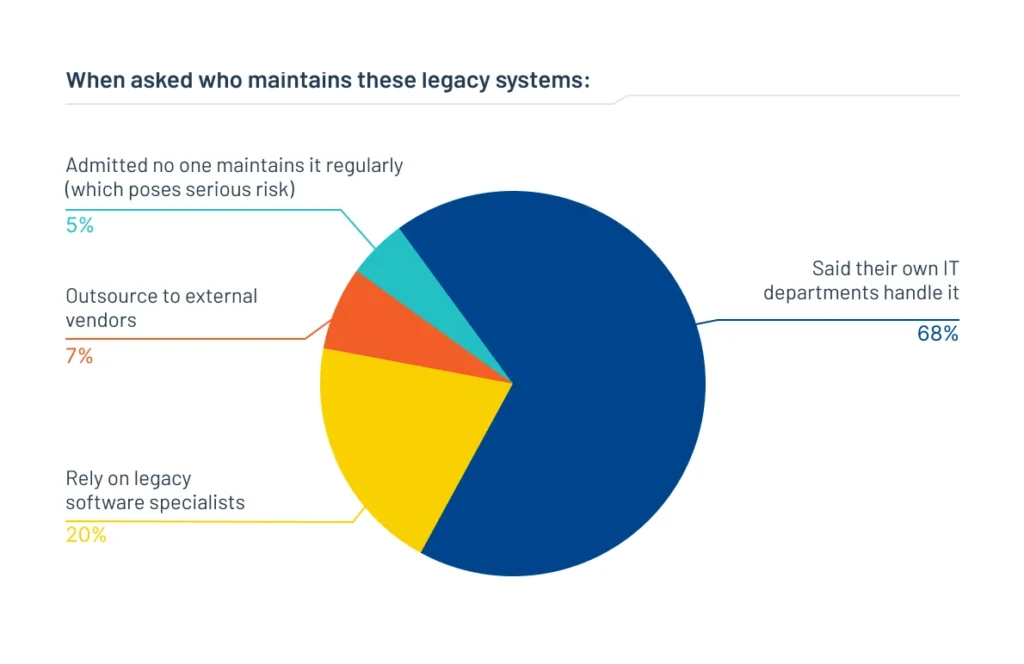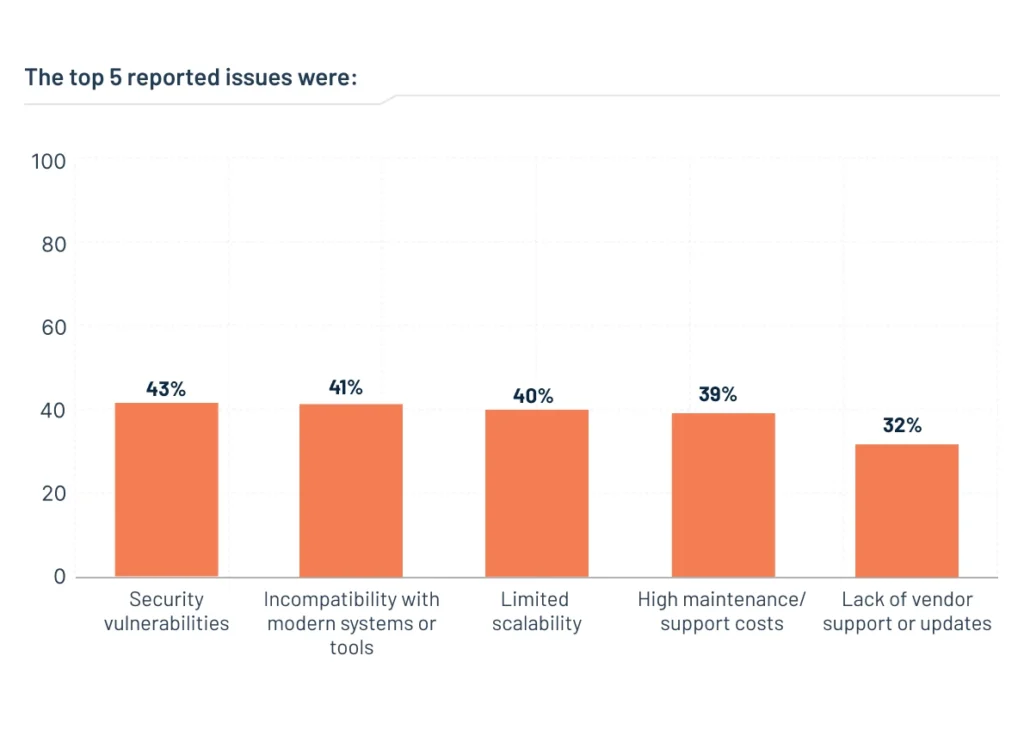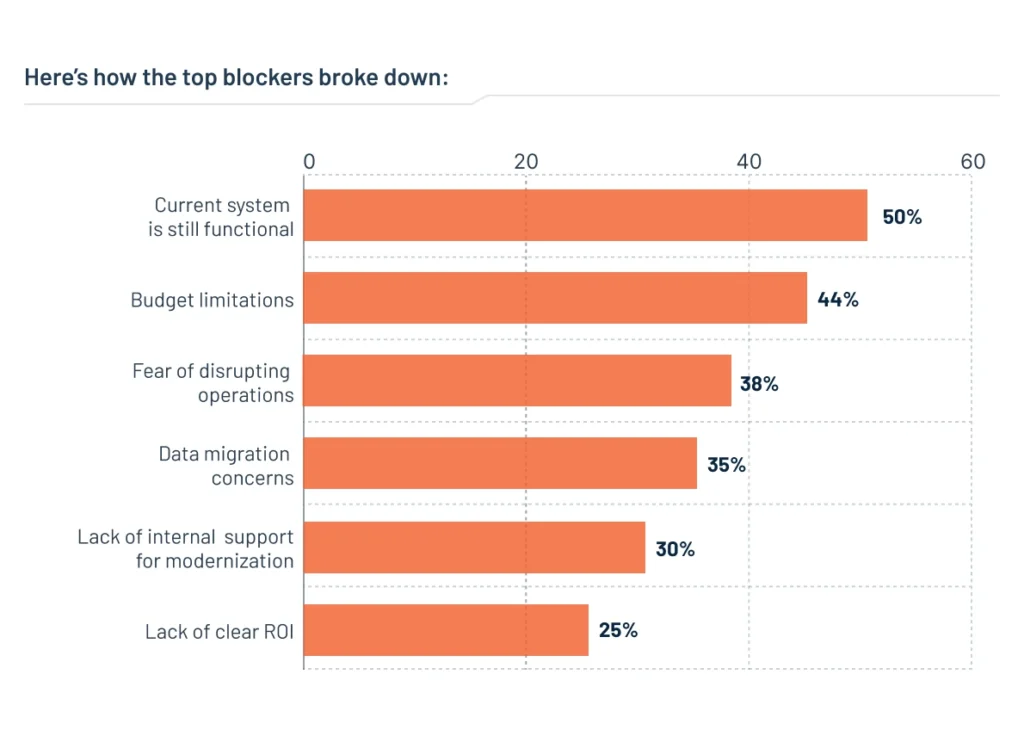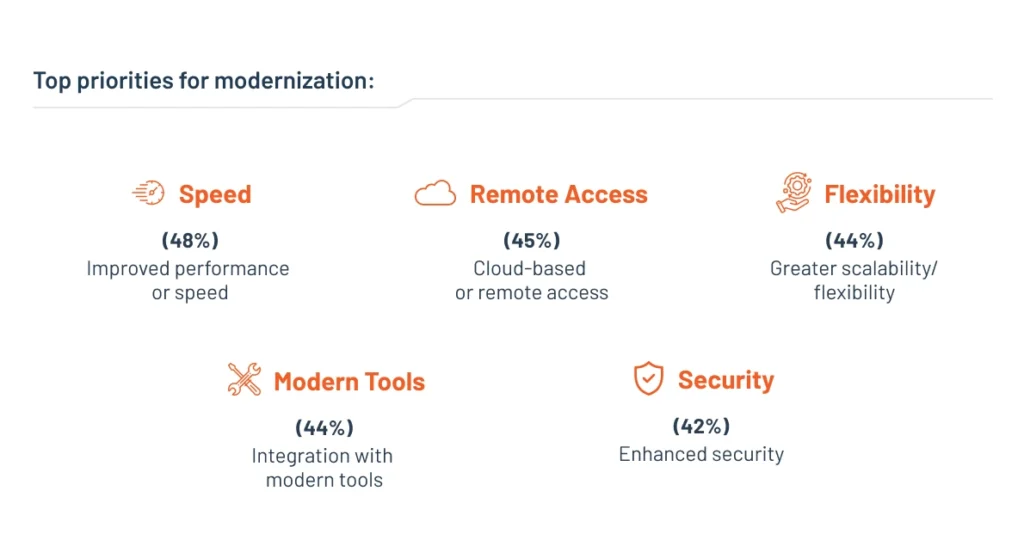A new 2025 survey of over 500 U.S.-based IT professionals reveals that 62% of organizations still rely on legacy software systems. Despite known security and performance risks, most teams are stuck maintaining outdated platforms and are struggling to modernize.
This article breaks down the latest data on legacy software modernization, including the top challenges, reasons for delay, and what IT leaders want from modern systems. Download the full report below.
What is Legacy Software Modernization?
Legacy software modernization is defined as the process of upgrading or replacing outdated systems to improve performance, security, usability, and compatibility with modern tools. This includes moving from on-premise infrastructure to the cloud, updating core platforms, or rewriting legacy code to support new business needs.
Summary of Key Findings
62% of organizations still use legacy systems
43% say security vulnerabilities are a major concern
68% rely on their internal IT team for maintenance
50% say the biggest reason they haven’t upgraded is because “the current system still works.”
48% say performance improvements are their top modernization goal
Who We Surveyed
We surveyed 504 IT professionals across industries and company sizes.
-
Company sizes:
- 1–99 employees: 15%
- 100–999: 38%
- 1,000+: 47%
-
Industries represented:
- Technology/software: 65%
- Others: finance, government, healthcare, manufacturing
-
Roles:
- IT management: 53%
- Developers, engineers, analysts, project managers: 47%
This data represents a variety of experiences, from small IT teams wearing multiple hats to large enterprises navigating complex modernization efforts.
How Legacy Systems Are Maintained in 2025
Despite widespread awareness of the risks, legacy systems are still deeply embedded in most organizations. 62% of respondents said their organization continues to rely on legacy software.
When asked who maintains these legacy systems:
- 68% said their internal IT departments handle it
- 20% rely on legacy software specialists
- 7% outsource to external vendors
- 5% admitted no one maintains it regularly (which poses a serious risk)
 For many companies, maintaining legacy systems means supporting outdated codebases, navigating end-of-life products, or dealing with brittle integrations. And these challenges are often compounded by limited documentation and shrinking institutional knowledge from natural turnover.
For many companies, maintaining legacy systems means supporting outdated codebases, navigating end-of-life products, or dealing with brittle integrations. And these challenges are often compounded by limited documentation and shrinking institutional knowledge from natural turnover.
Top Legacy Software Challenges in 2025
When asked about their legacy software’s biggest challenges, IT professionals pointed to the issues that cause the most disruption and risk.
The Top 5 reported issues were:
 Security concerns are especially pressing, exacerbated by the fact that many legacy platforms no longer receive patches or updates. This creates vulnerabilities that are difficult, or even impossible, to address.
Security concerns are especially pressing, exacerbated by the fact that many legacy platforms no longer receive patches or updates. This creates vulnerabilities that are difficult, or even impossible, to address.
Just behind security is a growing frustration with system incompatibility. As legacy tools fail to integrate with modern platforms, IT teams are forced to operate in disconnected silos. Valuable data often becomes trapped in outdated systems, making it harder to get a complete view of operations and slowing down business decision-making.
This fragmentation also limits an organization’s ability to evolve. From modern cloud-based platforms to Artificial Intelligence and machine learning, today’s technologies require access to large volumes of well-structured, unified data. Legacy systems make that nearly impossible.
In short, legacy software isn’t just outdated, it’s actively getting in the way of innovation.
Why Organizations Delay Legacy Software Modernization
The number one reason IT pros say they haven’t upgraded? “The current system still works.” Half of all respondents cited this as their primary blocker.
But “working” doesn’t mean optimal. And it’s undoubtedly not future-proof.
Here’s how the top blockers broke down:
- 50%: The current system is still functional
- 44%: Budget limitations
- 38%: Fear of disrupting operations
- 35%: Data migration concerns
- 30%: Lack of internal support for modernization
- 25%: Lack of clear ROI

The most pervasive hurdle is complacency, believing the current system “works well enough”. That mindset underpins at least three of the top six blockers:
- If the system still works, there’s less urgency to act
- Without urgency, there’s often limited internal buy-in
- Without buy-in, it becomes difficult to prove ROI
And so the cycle continues. Legacy software modernization is pushed aside because it’s politically or financially inconvenient.
Yet ironically, the best time to modernize is while systems are still working. Waiting until a legacy platform fails often leads to rushed, patchwork solutions and costly downtime. Proactive modernization reduces risk, improves long-term ROI, and avoids fire-drill emergencies.
Budget constraints, the second most-cited blocker, create a different trap. As legacy systems age, maintenance and support costs climb, often consuming a growing share of the IT budget. This leaves teams with less and less room to invest in modern infrastructure, reinforcing the status quo and delaying long-term progress. The majority of IT budgets go towards maintaining legacy systems, rather than new technologies or improvements (Source).
In other words, legacy systems may appear “cheaper” on the surface, but they’re often more expensive to maintain than to replace.
What IT Teams Want from Modernized Systems
When asked what they’d prioritize in a modernized system, IT professionals were clear: they want solutions that are faster, more flexible, better connected, and ready for growth.
Top Priorities for Modernization:
- Improved performance or speed (48%)
- Cloud-based or remote access (45%)
- Greater scalability/flexibility (44%)
- Integration with modern tools (44%)
- Enhanced security (42%)
 Additional priorities included better analytics, automation, and long-term cost savings. All of which are clear signs that IT teams want to evolve beyond the limitations of current legacy systems.
Additional priorities included better analytics, automation, and long-term cost savings. All of which are clear signs that IT teams want to evolve beyond the limitations of current legacy systems.
Legacy Software Modernization Unlocks New Opportunities
Organizations that modernize their platforms position themselves to take advantage of powerful technologies like AI, automation, and advanced analytics. These tools are quickly becoming essential for making smarter decisions, increasing efficiency, and staying competitive. After all, the AI market is predicted to reach 826 billion by 2030, after growing 268% between 2023 and 2024 (source).
- AI helps teams identify patterns, predict outcomes, and personalize experiences at scale.
- Automation streamlines repetitive tasks, reduces manual errors, and frees up valuable time.
- Analytics turns raw data into actionable insights that drive strategic decisions.
However, all of these capabilities rely on clean, connected, and accessible data, which legacy systems often can’t provide. Legacy systems trap data in silos, prevent modern integrations, and limit performance.
Even more concerning is the growing risk to data integrity and security. Legacy systems often lack modern protections, making them vulnerable to breaches, data loss, and compliance failures. Valuable historical data can be lost entirely if a legacy platform fails without proper backups.
Modern platforms, by contrast, are designed for agility. They offer built-in APIs, cloud accessibility, stronger security protocols, built-in redundancy, and scalable architecture designed to support the evolving needs of the business.
Strong software enables faster growth, smarter operations, and stronger customer experiences. Legacy software modernization isn’t just about keeping up; it’s about staying ahead.
Legacy Modernization Challenges by Role and Company Size
While the specific challenges vary by company size and role, the underlying friction is nearly universal: modernizing legacy systems is hard, no matter who you are.
Smaller businesses are often more tolerant of outdated tools, not because they’re unaware of the risks, but because budget and resource constraints make modernization difficult to prioritize. If the system still works, it’s easy to justify postponing upgrades.
Larger enterprises, on the other hand, face a different set of pressures. They’re more likely to report concerns around:
- Data migration complexity
- Escalating maintenance costs
- Lack of vendor support for legacy platforms
They may have the budget, but also have deeper entanglements, more stakeholders, and a higher level of risk associated with change.
Role also plays a factor. Middle managers (often those tasked with executing modernization plans) reported the most significant strain in balancing innovation with operational continuity. IT leaders may see the long-term need for change, while individual contributors feel the daily friction of outdated systems without the authority to address them directly.
Despite these nuances, the common thread is clear: Legacy modernization is a shared challenge across the board. Whether you’re managing a small team or running global infrastructure, success depends on cross-functional alignment between IT, finance, and leadership.
Legacy Software Modernization is an Investment in the Future
Despite growing security, scalability, and cost concerns, most organizations still rely on legacy software. Why? Replacing entrenched software systems is hard work that requires an investment of time, money, and effort across the organization.
But the risk of inaction is growing. Legacy platforms are harder to secure, maintain, and integrate with the tools businesses rely on today.
For IT leaders, the question isn’t whether to modernize, it’s how to do so without disrupting the business. The first step is understanding the scope of the challenge and aligning stakeholders around shared goals. To get everyone on the same page, legacy software modernization needs to be seen as a strategic investment in long-term agility, security, and performance.
Saritasa helps businesses modernize legacy systems with smart planning, efficient architecture, and zero-downtime deployment strategies. Contact us to start your legacy software modernization journey.
Recommended for You
Check out related insights from the team
Get empowered, subscribe today
Receive industry insights, tips, and advice from Saritasa.